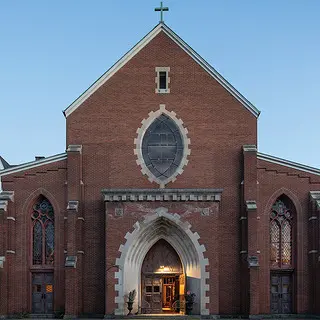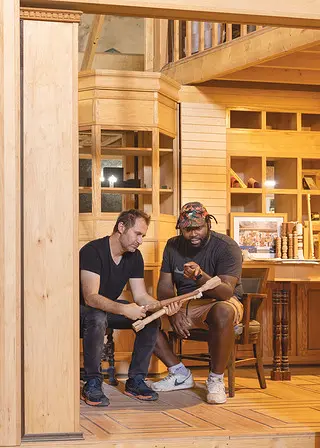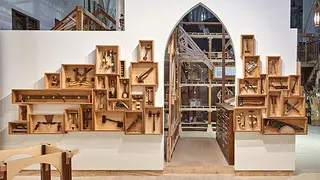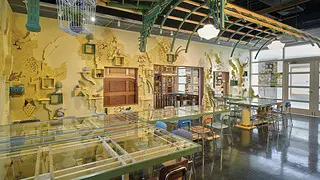
In Buffalo, New York, An Artist Pushes the Boundaries of Historic Preservation
Through the nearly 25 years since Dennis Maher moved to Buffalo, the city—once a case study in deindustrialization, more recently a locus of investment and development in western New York—has embodied the sorts of fluctuations he sees ceaselessly coursing through urban landscapes. “The city is constantly evolving,” says Maher. “Its parts are shifting. This building [that I’m in right now] is changing in subtle and not-so-subtle ways.”
An artist and designer, as well as clinical assistant professor and director of building arts in the School of Architecture and Planning at the University at Buffalo, Maher harnesses that sense of inexorable change to use in creative works that blur the borders between the arts, architecture, and the building trades. They range from sculptures crafted from fragments of demolished buildings to a decommissioned Roman Catholic church he turned into an education space for emerging craftspeople and tradespeople; from the idiosyncratic home he’s spent the past 16 years shaping into what he calls an “architectural dream world” to a new partnership with Buffalo civic institutions seeking to honor devastated buildings by salvaging their essential elements. And rather than always fixing the past in place, Maher’s attitudes toward preservation embrace the ebbs and flows of time.
“What does [preservation] mean in that context—in having that openness to movement, to time, and to change?” he asks.

photo by: David Schalliol
Dennis Maher (at left) with a team member at an Assembly House workshop in 2022.
Originally a painter who grew up drawing the row houses in his native Baltimore, Maher studied architecture at Cornell before arriving in Buffalo in 2002. Back then, he supplemented his income as an adjunct architecture professor by laboring on demolition crews, finding ample work in a city dealing with thousands of vacant, decaying buildings. Deconstructing historic spaces like the rear portion of the 1870 Farrar Mansion (where he also helped preserve details in the front part of the adaptively reused building) profoundly affected him. “I could feel it with my entire body, that kind of movement of things and the intensification of change,” Maher says. “ … It was important to me to think about all these abandoned buildings somehow as assets, rather than liabilities.”
Maher quietly collected demolition-site detritus—paneling, tiles, shingles, all pieces containing “embodied energy,” he says—and created large-scale sculptures as homages to places undergoing change. Exhibited as temporary installations in galleries both locally and in places such as New York and Detroit, the sculptures enabled him to find creative depths he couldn’t reach with a paintbrush. “Working with the literal fabric of the city was, for me, transformative.”
In 2009, with a critical mass of debris-based sculptures and a desire for longer-term creative explorations, Maher paid $10,000 for two homes—an 1890s two-family house and an 1870s cottage—on Buffalo’s West Side that had been looted and likely fated to become a parking lot.
Dubbed The Fargo House and now including a third house next door, the complex today serves as Maher’s home, as well as a laboratory for experiments in art, architecture, and living. “I’m interested in making environments that really remove you from the everyday,” he says, “and create an intensified sense of wonder, of delight, of joy, using found and rebuilt pieces.” The interiors contain phantasmagorias of furnishings, books, antique dollhouses, and other found and salvaged objects, while also serving as the locus of processes he has likened to an archaeological dig into the layers of the house, physically cutting through structures and scraping away coats of paint and wall coverings.

photo by: Biff Henrich
Antique tools are displayed inside the Assembly House in boxes created by apprentices.
Through The Fargo House, Maher struck up relationships with carpenters, plumbers, electricians, and others working in building and preservation trades. (“Many of them secretly think of themselves as artists, and they don’t really want to admit it,” he says.) In 2014, he purchased the Immaculate Conception Church—a long-abandoned structure in Buffalo’s Allentown Historic District. There he created and serves as director of The Assembly House, a nonprofit educational and cultural site where students (both adults and high-school age) convene with carpenters, masons, stained-glass specialists, and other craftspeople. In 2024, he secured a National Trust grant to help replace the building’s leaking roof.
Stay connected with us via email. Sign up today.
The core of The Assembly House centers on programs such as the Society for the Advancement of Construction Related Arts (SACRA), in which adult students spend eight weeks learning skills like wood framing, drywalling, and basic cabinetry in order to secure jobs and apprenticeships. Still, a glimpse at the student projects crowding the Neo-Gothic interior—like the Cabinet Drawer Room, a riff on Victorian-era houses and private studies with built-in shelves, a bay-window-turned-bookcase, and inlay floors, all set on wheels—reveals a deeper sense of whimsy and wonder than a strictly vocational enterprise might allow.

photo by: Biff Henrich
An installation by Dennis Maher and The Assembly House team at Burchfield Penney Art Center.
“[We’re] trying to sharpen perspectives and awareness around people’s ability to shape the environments within which they live,” Maher says, noting that displaying the Cabinet Drawer Room led to a commission for him and The Assembly House team to create Interfield, a nearly 2,000-square-foot immersive installation currently on display at Buffalo State University’s Burchfield Penney Art Center.
In early 2025, Maher, the city of Buffalo, and The Buffalo History Museum announced a long-term partnership focused on preserving the remnants of historic buildings lost to demolition. Two structures in the Allentown district that were recently lost to fires, the 1897 Dearing building and the dive bar The Old Pink, inspired the project. “You wouldn’t think of them as traditional architectural landmarks, but the public response was enormous because they were so woven into the fabric of people’s lives,” Maher says.
Still in its nascency, the partnership centers on salvaging architectural remnants, like the Dearing building’s cast-iron pilasters, to celebrate the memory and narratives embedded in cherished structures too far gone to be saved.
Across the breadth of Maher’s work, there are throughlines: reclaiming connections to physical reality that are tenuous in the digital age, holding on to lost arts and traditional skills that are at risk of disappearing. “But equally important, [they’re intended] to create new sites for the collective imagination,” he says. “To harness some of the possibilities of the past, both in terms of the literal material fabric as well as the techniques and knowledge of the way to build, [and] to create things that are new, inspiring, and speak to new generations of people and to the city of the future.”
Donate Today to Help Save the Places Where Our History Happened.
Donate to the National Trust for Historic Preservation today and you'll help preserve places that tell our stories, reflect our culture, and shape our shared American experience.


